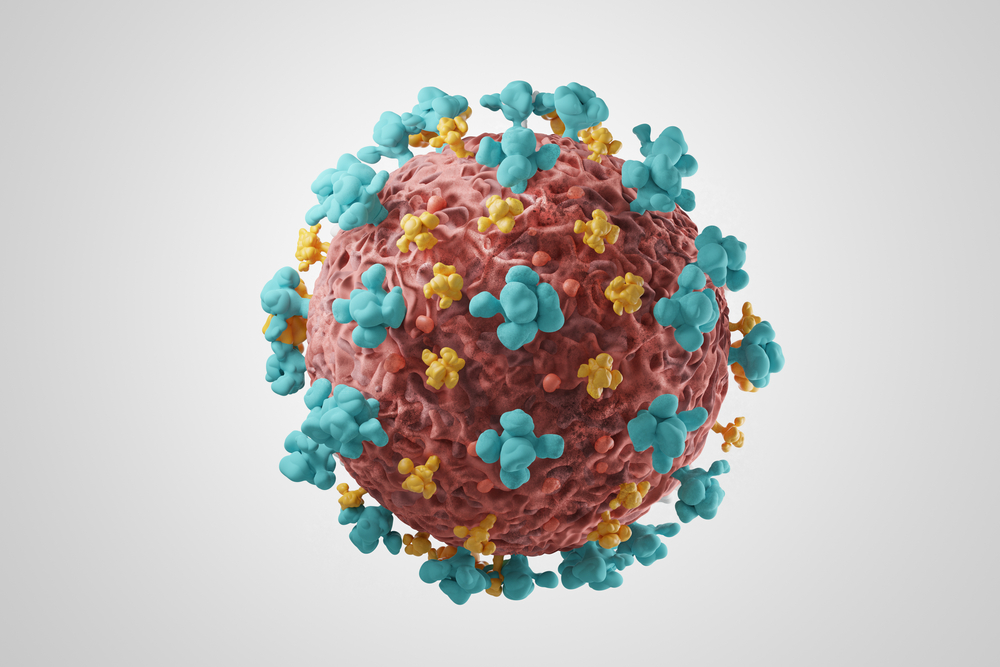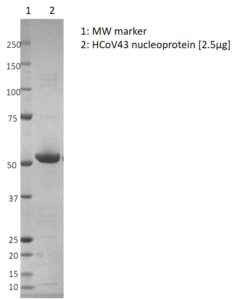Human Coronavirus OC43 Nucleoprotein, His-Tag (E. coli)
Price range: $678.97 through $2,547.68 excl. VAT
Human coronavirus OC43 nucleoprotein is a recombinant HCoV-OC43 nucleocapsid protein, with 6xHis-tag. This antigen is manufactured in E. coli cells, with
HUMAN CORONAVIRUS OC43 NUCLEOPROTEIN, HIS-TAG (E. COLI)
Human coronavirus OC43 nucleoprotein is a recombinant HCoV-OC43 nucleocapsid protein with C-terminus 6xHis-tag, purified from E. coli to greater than 95%.
PRODUCT DETAILS – HUMAN CORONAVIRUS OC43 NUCLEOPROTEIN (S1)
-
- Human coronavirus OC43 nucleoprotein, corresponding to amino acids 1-447 (HCoV_OC43/Seattle/USA/SC0841/2019).
- Protein contains a C-terminal sheep His-tag with apparent molecular weight of 52 kDa.
- Protein was produced in E. coli and purified by immobilised metal affinity chromatography and dialysis.
- Presented as liquid, 20mM phosphate monobasic, 25mM potassium carbonate pH 10.0, 150mM NaCl.
BACKGROUND
The alphacoronaviruses HCoV-NL63 and HCoV-229E and the betacoronaviruses HCoV-OC43 and HCoV-HKU1, are pathogens responsible for common cold symptoms in humans worldwide. Human coronavirus OC43 (HCoV-OC43, species BetaCoV 1) was first isolated in 1967 based on human tracheal explants kept in organ culture (OC), and is regarded as the most common human coronavirus worldwide (Tyrrell & Bynoe, 1965). HCoV-OC43 comprises strains detected in highly divergent host species and is thought to have emerged from ancestors in domestic animals such as cattle or swine. Because of the sequence similarities between HCoV-OC43, bovine coronavirus (BCoV) and canine respiratory coronavirus, it is believed that zoonotic transmission to humans may have occurred relatively recently, during a human respiratory disease pandemic in 1890 (Vijgen et al., 2005; Corman et al, 2018). Unlike other alpha- and betacoronavirus species, BetaCoV1 and the related mouse hepatitis virus (MHV) and HCoV-HKU1 do not appear to have ancestral links to bats.
Coronavirus enters the cell via the endocytic route by binding to the host cell attachment receptor, which results in an increased cell surface density of virus particles and (or) facilitates interaction with the fusion receptor. HCoV-OC43 was reported to utilize HLA class I molecule or sialic acids as fusion receptors and to enter the host cell; HCoV-OC43 and bovine coronavirus both bind to N-acetyl-9-O-acetylneuraminic acid (Collins, 1993). The human betacoronaviruses, including HCoV-OC43, are predominantly associated with respiratory tract infections. The group includes viruses that cause the severe acute respiratory syndrome and the Middle East respiratory syndrome. HCoV-OC43 shows highest incidence during winter and spring months (Owczarek et al., 2018 and is associated with respiratory tract illnesses of varying severity (Vabret et al., 2003). It has also been shown to have neuroinvasive properties and in vivo studies in mice have shown that HCoV-OC43 can infect neurons and cause encephalitis. The virus has also been shown to cause persistent infections in human neural-cell lines.
REFERENCES
- Collins AR. HLA class I antigen serves as a receptor for human coronavirus OC43. Immunol Invest. 1993;22(2):95-103.
- Corman VM, Muth D, Niemeyer D, Drosten C. Hosts and Sources of Endemic Human Coronaviruses. Adv Virus Res. 2018;100:163-188.
- Owczarek K, Szczepanski A, Milewska A, et al. Early events during human coronavirus OC43 entry to the cell. Sci Rep. 2018;8(1):7124.
- TYRRELL DA, BYNOE ML. CULTIVATION OF A NOVEL TYPE OF COMMON-COLD VIRUS IN ORGAN CULTURES. Br Med J. 1965;1(5448):1467-1470.
- Vabret A, Mourez T, Gouarin S, Petitjean J, Freymuth F. An outbreak of coronavirus OC43 respiratory infection in Normandy, France. Clin Infect Dis. 2003;36(8):985-989.
- Vijgen L, Keyaerts E, Moës E, et al. Complete genomic sequence of human coronavirus OC43: molecular clock analysis suggests a relatively recent zoonotic coronavirus transmission event. J Virol. 2005;79(3):1595-1604.


